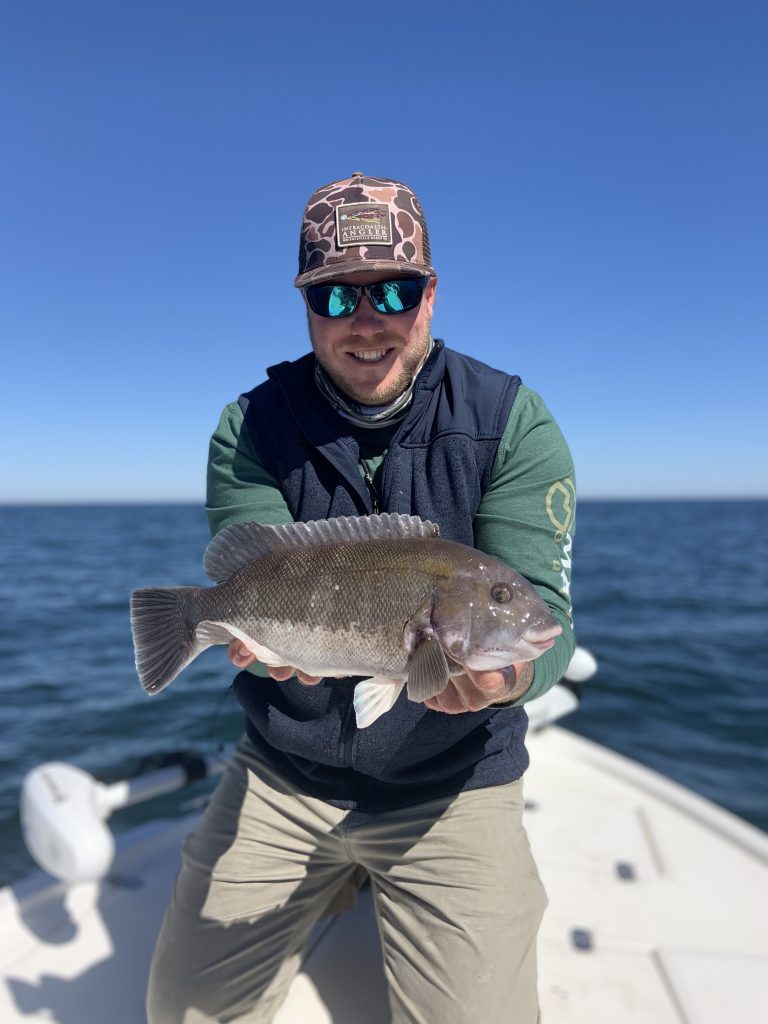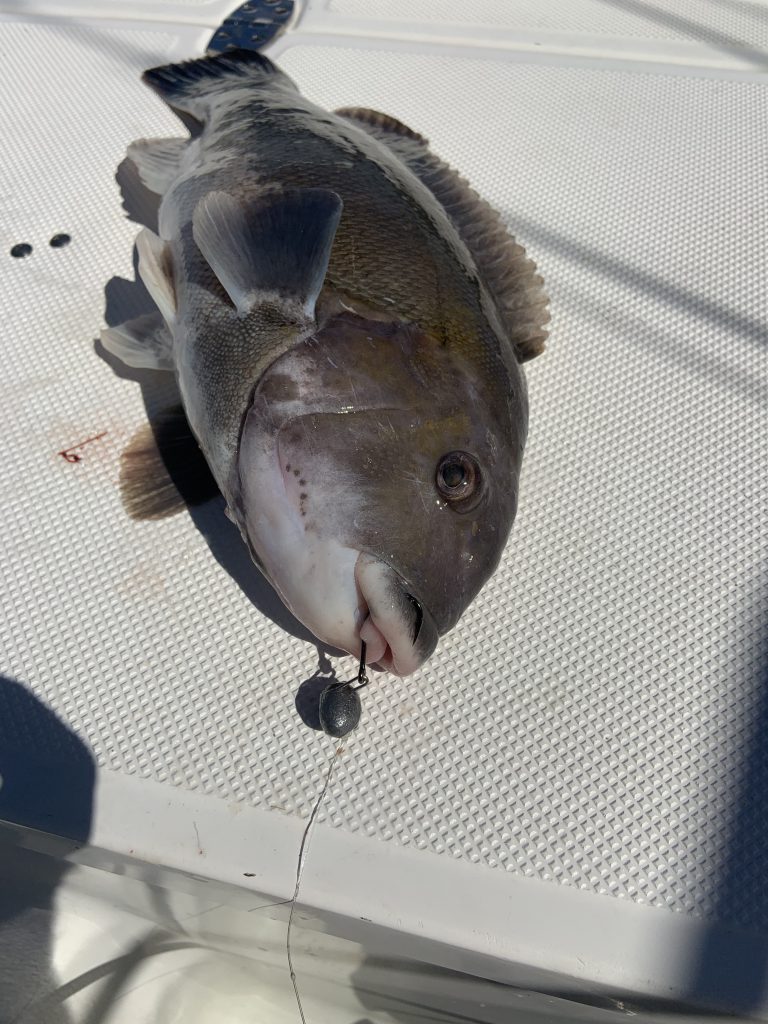Tidelines – March 2021
It’s been a winter.
Whether it’s Covid contact that turned out to be nothing, Covid contact that turned out to be something, the cold, or the rain rain rain rain rain rain rain…a fishing trip with Capt. Zane Long, of Falling Tide Fishing Adventures out of the Wrightsville Beach, area could not have been a better fix to turn attention from the winter towards the spring.
Our goal was to find a few tautog on some nearshore structure. Fishing for tautog (and sheepshead) in the ocean is one of Zane’s specialties, but the handicap I put on Zane was pretty daunting—I had to be back to the docks by 10:00 am so that I could be in my CFCC classroom by 11:00 to teach business writing.
Zane had scouted out the Liberty Ship a few days prior and found it to be covered up with ringtails and 3-6” sea bass, so we pushed a little further out to some structure (scattered concrete) in about 60’ of water.
Still some small sea bass were to be expected to be a nuisance in our search for tautog, but he was really hoping the deeper water would help to avoid the ringtails.
“Sea bass mostly stay on the bottom,” he told me while playing with the remote control for the GPS trolling motor he just deployed. “Schools of small ringtails, though, can stack up on top of each other and steal your bait before it even makes it to the bottom.”

Capt. Zane Long, of Falling Tide Fishing Adventures, with a tautog caught nearshore off Wrightsville Beach on a piece of shrimp.
Zane likes the First Flight Lures swing jigs, so each of our rods were rigged with the 1 oz. version, which is basically a 2/0 hook attached directly to a modified egg weight in a fashion that lets the hook “swing.” He had a bag of shrimp and a bucket of some small live crabs he had gathered the evening before. I was given a crab, and he dropped some shrimp.
For my crab, or any crab, the technique is to take the hook and go in though a leg socket and then out through a soft part of the belly. Zane’s found that exiting the hook through a harder shell area just creates a crack, and then that crack causes a loss of integrity, opens up the shell, and creates an entry point for the smaller, undesirable fish to eat away all the good stuff.
Hooking the shrimp is also straight forward—pinch off the end of the tail, and then feed the shrimp onto the hook like a worm, looking for the hook to sit in the natural curve of the shrimp, so that your shrimp bait more closely resembles a shrimp and not just a ball of shrimp.
Liking what he saw on his machine, I was given the go ahead to drop. I love instructions and asked what he wanted me to do when my bait reached the bottom. Trying to target these bait-stealing fish with charter clients can be quite a task, and Zane was ready to offer me the standard instructions he gives to all of his clients when ocean fishing for tautog or sheepshead.
“You want to hold it on the bottom without it touching the bottom,” he explained with a smile. “Does that make sense?”
It did, but he was prepared for the follow up.
“Once it hits the bottom,” he continued, “then just bring it up as little as possible to where you are holding the bait just off the bottom. The idea is for it not to be sitting on the bottom because that can cause you to not feel the bite and miss the bite.”
And once on the bottom he likes to tell clients to reel down so that your rod tip is just above the surface of the water, as that way you have the most room for a good hook set.
As I got my bait just off the bottom and my rod tip in position, Zane added, “You want room for a good hook set because tautog will dig for the bottom like a grouper. You have to be able to get them quickly off the bottom.”
I felt a small tick and then another small tick. I suspected that I had already lost my bait, but then I felt a third tick and this time the tick felt a little heavier. I set the hook, but my light tackle setup didn’t struggle much as I brought my fish up through the water column.
It was a small sea bass, but Zane had already prepped me. Small sea bass were to be expected.
I kept re-baiting with crabs, and Zane stuck with shrimp. He likes how shrimp create a little chum slick down at the bottom and get everything stirred up. The shrimp are serving a beneficial purpose even if they’re not bringing up tautog immediately.
And this is typically the spot in my Tidelines column where Zane and/or I then hook the tautog (or two or three or more), but that didn’t happen. We ran out of time and stowed the trolling motor by 9:15 so that we had time to get me back to the WB ramp by 10:00.
However, Zane had a fishing buddy ready at the ramp to take my spot on the boat, and the two of them went back out and did find the target species. They, as expected, had to weed through smaller sea bass and some ringtails, but found a quick three tautog all within close proximity to each other.

A close-up of the First Flight Lures swing jig that Capt. Zane Long uses for tautog and sheepshead. The rig is baited with shrimp or a small live crab.
Zane’s familiarity with tautog started while growing up in the Maryland area, and since fishing for them off the North Carolina coast, he has found scattered fish as early as late October, and while he can still find a few fish even into April, the predominant bite for these fish is from November to January.
So your tautog window is closing, but Zane typically hooks his biggest sheepshead in the ocean around Easter.
And if battling the subtle bait steelers isn’t your thing, then Zane offers a host of interactive, light tackle fishing trips throughout the year, from nearshore flounder, to inshore trout and redfish and flounder, to vertical jigging and casting metal to spanish mackerel.
You can give him a call at (434) 222-3066 or visit him at www.fallingtidefishingadventures.com.
As long as you give him a fighting chance (give him more than an hour or so of fishing time), Zane’s likely to deliver.
